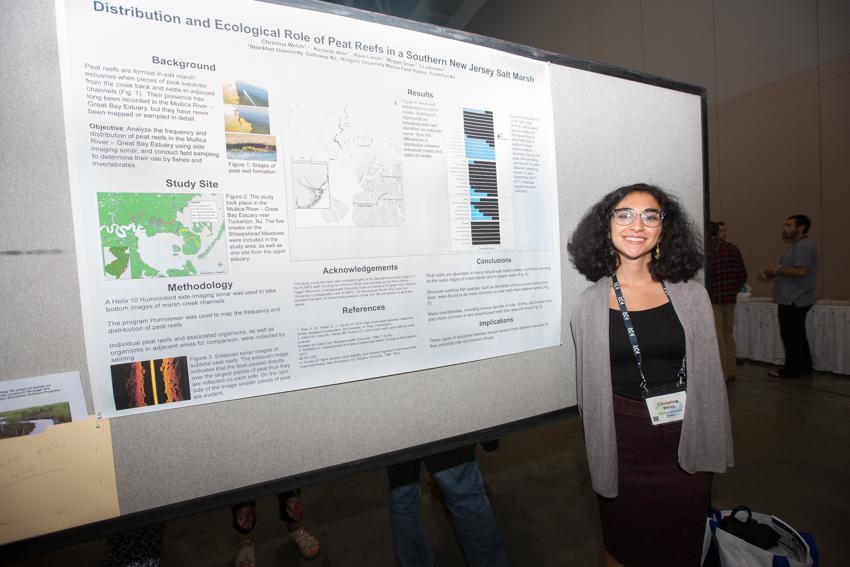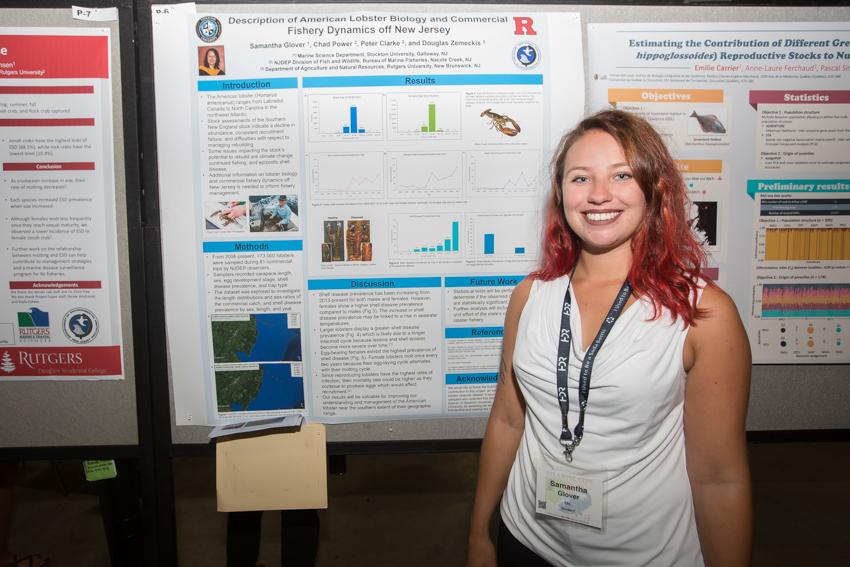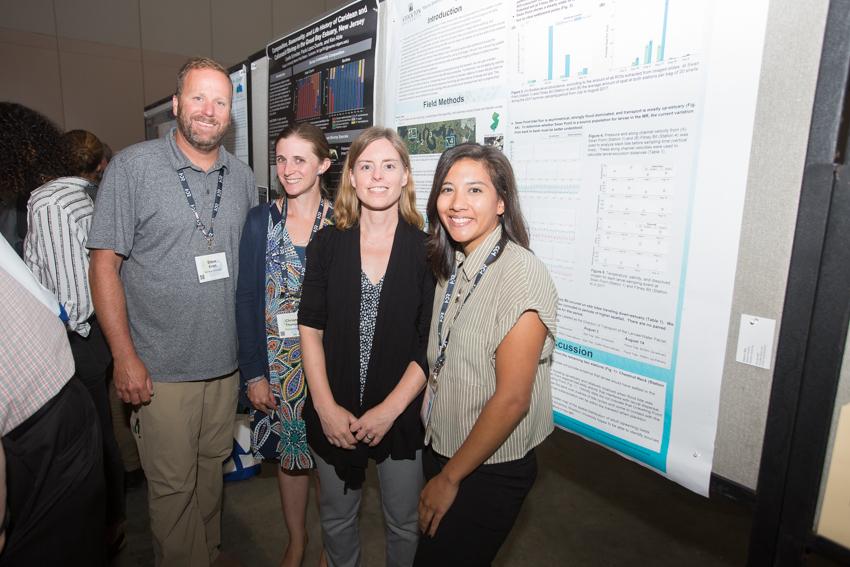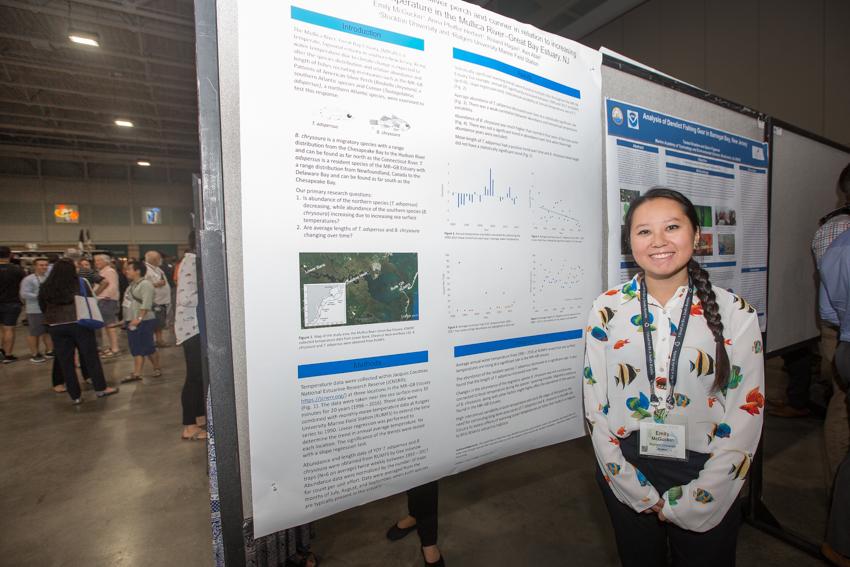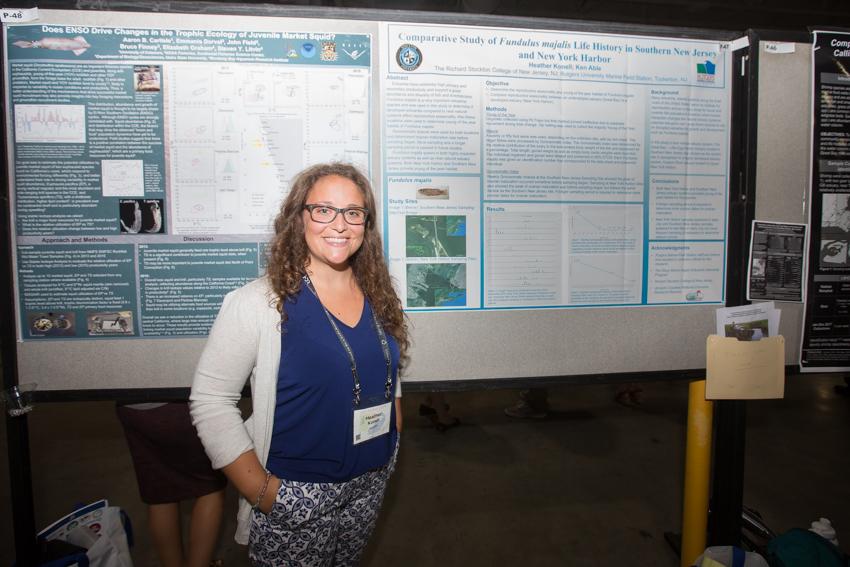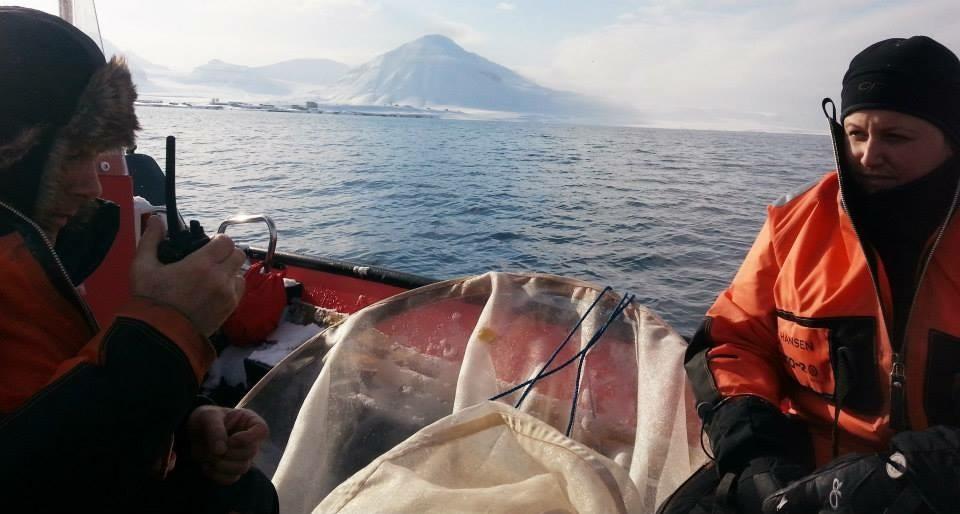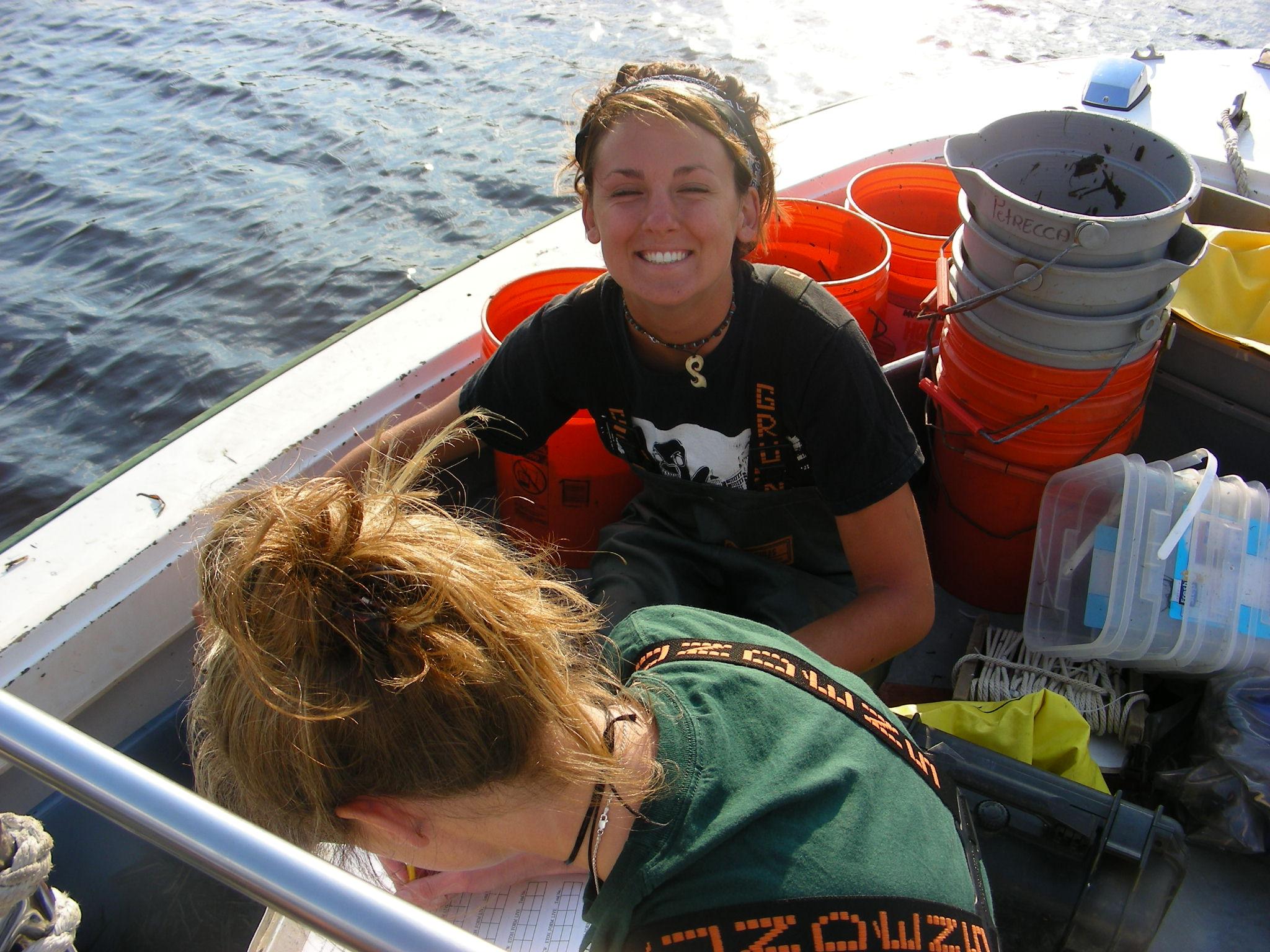Stockton Graduates Present a Decade of Research to Honor Stacy Moore Hagan’s Legacy

Stacy Moore Hagan looks out into the saltmarsh on Hog Island. Stockton graduates presented a decade of research to honor Stacy Moore Hagan’s legacy as a pioneer marine scientist at the 148th Annual Meeting of the American Fisheries Society.
Turning the Tide
On a wave-less summer beach day, Roland Hagan ’90 abandoned his boogie board and set out to explore Manasquan Inlet equipped with a K-Mart mask and kitchenware.
In just three hours, he had amassed an armful of fishing tackle, a stringer of fish, a growing fascination in sea life and worried parents.
His focus was broken by the sound of his name being called. “I hadn’t realized how fast the time went by,” recalls Hagan.
That day, his parents decided that their son would need the proper training to pursue his interests beneath the surface. By age 12, he was certified by the Professional Association of Diving Instructors, and in high school, he was gaining hands-on experience at NOAA’s National Marine Fisheries Service in Sandy Hook.
Hagan remembers his early dives, paid for by his paper route, for how they “opened my eyes to what was under the water. They were formative to my career.”
A “child fish” is how Hagan defines his early years.
While Hagan swam with the fish, a little girl growing up further inland chose books before the beach. “At nine-years-old, I couldn’t get her to go in a swimming pool,” remembers Stacy Moore’s mother, Doris.
She excelled in her studies, taking honors and advanced placement courses in high school, and the softball field is where she shined as an athlete under her father Ed Moore’s coaching. Naturally drawn to math and computers, she was dedicated to her education.
At a Stockton orientation, Hagan and Moore crossed paths. Hagan, a senior Marine Science major, president of the Scuba Diving Club and a student activities employee who worked as a manager in N-Wing, was working as a tour guide introducing freshman to the campus. Moore was a student on his tour.
When Stacy told her mother she had chosen marine science as her major, she got a look of surprise.
“All I knew of marine science at the time was that I’d never seen a woman on Jacque Cousteau’s boat,” said Doris Moore.
“But the same little girl who didn’t want to get her hands dirty, was dedicated to marine science,” she explained.
“Roland turned the tide 180 degrees—all for the good,” she added.
Internships that Launch Careers
Roland Hagan was the first Stockton student to intern at the U.S. Coast Guard lifesaving station turned Rutgers University Marine Field Station (RUMFS) in Tuckerton his senior year. Stacy was the next.
Volunteer and intern experiences eventually led to technician positions at RUMFS for both Hagan and Moore, who married after they graduated from Stockton. Stacy’s salmon research took them to Oregon, but a master’s degree at Rutgers University brought them back to New Jersey.
“With each of those increases in responsibility (from volunteer to technician), it grew apparent that Stacy was dedicated, interested and involved. She became my right-hand person,” said Kenneth Able, director of RUMFS.
In a swarm of greenheads, behind the wheel of a boat, underneath layers of foul weather gear or sinking in muck, she naturally excelled proving herself as not only an effective and efficient scientist, but as a mentor to the summer interns who looked up to her with the utmost respect, Able explained.
While making a successful career filled with field work, publications and technical reports she and Roland were raising their son, Rutger, and daughter, Ryland. She was never too busy to plan themed birthday parties with handmade decorations bringing the children’s favorite books and movies to life.
As quickly as she was advancing as a scientist, Stacy was diagnosed with breast cancer. She remained a pillar of strength to everyone around her, but in 2007, at age 36, she lost her life too soon.
To honor his wife and continue her 17-year legacy as a marine scientist, Roland established an undergraduate scholarship program offering opportunities to students with the same thirst for knowledge and endless curiosity in the marine world.
To date, $57,500 in scholarship money has been awarded through the Stockton Foundation to 23 students who have interned at the Stockton or Rutgers Marine Field Stations. Six former interns have completed or are enrolled in master’s degree programs, two are enrolled in PhD programs and many are already working in their fields.
Stacy’s passion for science lives on through each internship project and mentoring experience carried out by enthusiastic students and dedicated mentors.
Thomas Johnson, a former intern, piloted a drone to capture a bird's-eye-view of the field research conducted in the saltmarsh. The film was featured as part of the movie room segment of the American Fisheries Society Annual Meeting. Johnson's internship looked at summer flounder and winter flounder habitat in three estuaries, and using drone images, he assessed how sampling gear works and how it could potentially skew accuracy.
Stacy's Spirit is Home in the Saltmarsh
The Rutgers University Marine Field Station and the surrounding saltmarsh ecosystem were Stacy's workplace and second home. To honor Stacy's deep connection to the saltmarsh, her ashes were released from the cupola of the Field Station by her husband, co-workers and friends. Jennifer Lamonaca, a former veteran technician, explained in a tribute article, "The landscape was peaceful and agreeably where she loved to be. The love in Stacy's heart ran deep and her soul was good and true. Her support and wisdom continue to form our thoughts and actions. People will come and go in our lives, however on the rare occassion, they will leave a watermark on our souls."
Folk Across the Street
Music was a constant that narrated Stacy and Roland’s life together, first through the radio, then expanding to monthly visits to West Creek’s Hometown Music Concert Series and blossoming after the four-day Falcon Ridge Folk Festival in Hillsdale, N.Y.
Roland’s mother had won tickets to the festival and gave them to her son to enjoy with his family. Their fondness for music grew stronger from that family trip.
When the ten-year Hometown Music Concert Series was coming to an end, Stacy and Roland wanted to carry forth the musical tradition, but the cancer diagnosis refocused their energies.
In forming the scholarship program, Roland browsed the imaginative “thesaurus of my head” and came up with Folk Across the Street, which would become a new concert series to keep Stacy’s spirit alive.
Concerts continue to bring Stacy’s family and friends together and help to raise funds for the scholarship internship program.
Connecting the Dots to Understand Seals
Linda Dotts was working as a claims case manager at a health care insurance company when she realized that her heart was set on working with animals. Her pursuit to begin a new career as a veterinary technician brought her to Stockton.
A single course in tidal marsh ecology with Pete Straub, now dean of the School of Natural Science and Mathematics, is how she fell in love with marine biology and decided to double major in Biology and Marine Science.
Before she even enrolled at Stockton, Dotts had read about Carol Slocum’s New Jersey seal study in the newspaper. As a student, she had the chance to learn about seal biology and behavior in Slocum’s course.
Slocum passed away shortly after Dotts took her course, leaving the seal study without its dedicated leader.
Mark Sullivan, associate professor of Marine Science, asked Dotts to stay after class one day while she was taking his Ichthyology course.
“Am I not going to be able to graduate,” was the first thought that raced through her mind, but what came out of their conversation was an opportunity to continue Slocum’s research through an internship in memory of Stacy Moore Hagan.
Dotts became the first student to intern at the Stockton Marine Field Station through the scholarship program.
“I was thrilled. I really admired what Carol did and felt honored,” said Dotts, who began her internship to keep the seal study going.
Although Linda never met Stacy, she felt as if she knew her. The Stockton and Rutgers marine science community “is like a family,” she said.
A Mentor, Mother, Scientist and Friend
“Linda spent an amazing amount of time finalizing the seal study,” said her internship mentor Jacalyn Toth, an adjunct professor who teaches marine mammal courses at Stockton.
Toth, an accomplished scientist herself, met Stacy when she landed her first job, a technician position at Rutgers, at 21 years old, fresh out of college. “Stacy led the way,” she explained, as they worked on Stacy’s research that examined how spartina (a saltmarsh grass) and phragmite affect killifish in the Mullica River.
Their work together involved capturing fish, releasing them with coded tags and recapturing them to collect data on their movements around Hog Island.
Anyone who knew Stacy has something wonderful to share about how she touched their lives, said Toth.
A young scientist just starting out hit the jack pot when they had Stacy guiding their experience and modeling the right way to do things. “They couldn’t have been in a better situation,” she added.
“You can’t even put into words the influence Stacy had. She was the person you wanted to be as a scientist, mother and friend. She played so many different roles,” she said.
With each internship, Stacy’s legacy is honored.
“We so appreciate Roland’s dedication to keeping her positive energy alive,” said Toth.
A Decade of Research
At the 148th annual meeting of the American Fisheries Society, held Aug. 19-23 in Atlantic City, past and present interns came together to present their research projects at a poster session and in oral presentations. Learn more about the Stacy Moore Hagan internship projects and where the interns are working now in the summaries below.
Poster Presenters
Samantha Glover (Faculty Advisor Douglas Zemeckis of Rutgers University):
Glover, a 2018 Marine Science graduate with a concentration in Marine Biology, works as a fisheries technician at the N.J. Fish and Wildlife Service’s Marine Fisheries Office on Nacote Creek. Her internship project focused on the American lobster and explored a dataset collected during 81 commercial trips by NJDEP observers. She investigated shell disease prevalence and found that shell disease has been increasing from 2013 to present with females having a higher prevalence. Larger lobsters don’t molt as frequently, giving the shell disease more time to develop and erode the shell, and egg-bearing females don’t molt during the egg-laying cycle, also giving the disease more time to intensify. The rise in seawater temperature may be a cause of shell disease.
Emily McGuckin (Faculty Advisor Anna Pfeiffer-Herbert of Stockton University):
McGuckin, a 2018 Marine Science graduate with a concentration in Marine Biology, is currently interning with the American Littoral Society in Sandy Hook where she’s gaining experience in fish tagging programs and training fishermen to participate in fish tagging. Her internship project looked at the changes in abundance of two species, silver perch and cunner, in relation to increasing sea surface temperature in the Mullica River Great Bay Estuary. She found that cunner, a northern species that is a local resident at the bottom of its range, is decreasing in abundance. Additional research is needed to determine changes for the silver perch, a migratory southern species that is at the top of its range locally. Multiple sample sites along its migration route are needed to make an accurate conclusion.
Christina Welsh (Faculty Advisor Kenneth Able of Rutgers University):
Welsh, a 2018 Marine Science graduate, works as a laboratory technician at the Rutgers University Marine Field Station. Her internship project looked at peat reefs, which form when chunks of the saltmarsh bank erode and settle into the channel. Although common, peat reefs had not been extensively mapped and sampled. She used sonar to make images of peat reefs to determine their frequency and distribution, and she found that they are abundant in saltmarsh creeks forming most often on the outer edges of creek bends and in deeper water.
Jessica Baez (Faculty Advisor Christine Thompson of Stockton University):
Baez, a 2018 Marine Science graduate with a concentration in Oceanography, works as a nursery manager for the Barnegat Oyster Collective. Her internship project looked at how tidal flow influences eastern oyster larval dispersal and where the developing oysters eventually settle in the Mullica River. In the plankton stage, oyster larvae drift in the current, making sampling efforts difficult. As the larvae grow, they become spat (baby oysters) and settle on hard substrate. Baez’s work compares settlement to larval abundance to gain an understanding of how subpopulations within the Mullica River are connected.
Heather Konell (Faculty Advisor Kenneth Able of Rutgers University):
Konell, a 2014 Marine Science graduate with a minor in Biology, is a senior data coordinator for the Atlantic Coastal Cooperative Statistics Program (ACCSP) in Arlington, Virginia. The data she works with informs policy and regulation decisions. From Maine to Florida, including the Gulf, ACCSP collects data from commercial fishermen and dealers. Her internship project took her to New York Harbor, an ecosystem affected by pollution, and Tuckerton, a pristine ecosystem, to sample for young-of-the-year killifish. She found that they are a hardy species that was supported by both habitats.
Posters Displayed
Theresa Venello (Faculty Advisors Jacalyn Toth and Mark Sullivan of Stockton University):
Venello, a 2012 Marine Science graduate, is now working off the west coast of Vancouver Island as a PhD candidate at the University of Victoria in Canada. She completed her master's in Svalbard, Norway. Her internship project focused on characterizing the diet of Great Bay’s overwintering Atlantic Harbor Seal population by analyzing otoliths (fish ear bones) found in seal scat. She found that flatfish dominate harbor seal diet as they are the most available prey all winter long, but increases in predation on herring and hake occur in late winter and early spring as these fish move into Great Bay. She notes that her internship "was truly a stepping stone for my career."
Maureen Duffy (Faculty Advisors Mark Sullivan and Steve Evert of Stockton University)
Oral Presentations
Victoria Musumeci (Faculty Advisor Kenneth Able of Rutgers University):
Musumeci, a 2009 Marine Science graduate and a 2011 Professional Science Master's graduate, is a marine technology student at Cape Fear Community College and an intern at Great Lakes Dredge and Dock. Her internship project studied the predator-prey interactions between two eel species, the American eel and the American conger eel, during their early life through field observations and laboratory experiments. Both species enter Great Bay and Little Egg Harbor Bay annually as larvae seeking sheltered habitat to grow and feed. The study found that American conger eels frequently predate American eels with the opposite interaction never occuring. The American conger eel is larger upon entrance to the bays and exhibits more aggressive behavior. The conger eel also begins arriving to the bays earlier, allowing them first choice in habitat while they settle. Musumeci is the first author in the resulting paper published in the peer-reviewed journal Environmental Biology of Fishes.
Linda Dotts (Faculty Advisor Jacalyn Toth of Stockton University):
Dotts, a 2010 Biology and Marine Science graduate, is now a laboratory support staff and administrator for the Institutional Animal Care and Use Committee within Stockton's School of Natural Sciences and Mathematics. Her internship project looked at the foraging patterns of Atlantic harbor seals overwintering in the Great Bay-Mullica River estuary. She recovered 1,419 otoliths (fish ear bones) from 142 scat samples and identified them on the order, family or species level. The data revealed that overwintering seals are opportunistic feeders preying mostly upon adult and large juvenile perch, herring and cod.

